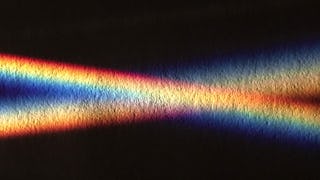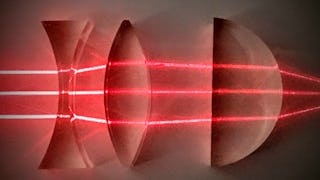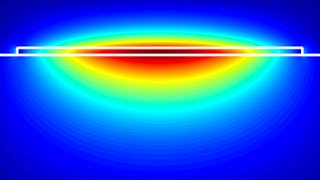This course can also be taken for academic credit as ECEA 5600, part of CU Boulder’s Master of Science in Electrical Engineering degree.

Early bird sale! Unlock 10,000+ courses from Google, IBM, and more for 50% off. Save today.


First Order Optical System Design
This course is part of Optical Engineering Specialization

Instructor: Robert McLeod
22,685 already enrolled
Included with 
(330 reviews)
What you'll learn
be able to design, to first order, such optical systems with simple mathematical and graphical techniques
Skills you'll gain
Details to know

Add to your LinkedIn profile
13 assignments
See how employees at top companies are mastering in-demand skills

Build your subject-matter expertise
- Learn new concepts from industry experts
- Gain a foundational understanding of a subject or tool
- Develop job-relevant skills with hands-on projects
- Earn a shareable career certificate

There are 5 modules in this course
This module introduces rays, which we use to describe the motion of light through air and materials. The course overview describes the goals of this course and gives tips on how to make the best use of the course materials to be successful. The lectures introduce the material. The in-video questions, lab demonstrations, PhET interactive demonstration, practice problems, and homework assignment allow you to get actively involved in learning the material.
What's included
9 videos3 readings3 assignments4 discussion prompts
In this module, you will learn how to enter the description of an optical system into OpticStudio, analyze the performance of that system using various calculations and plots, and finally optimize that design by defining a merit function and search variables.
What's included
7 videos5 readings1 assignment1 discussion prompt
This module applies Snell's Laws to the curved interfaces of lenses and mirrors. You will learn the graphical and mathematical tools you need to calculate image size and location for thin lens and mirror systems. This foundation is essential to build more complex optical systems.
What's included
12 videos1 reading3 assignments1 discussion prompt
This module extends the analysis of the previous module to include the effects of real, thick lenses. You will learn how to input this factor into your optical system analysis and design.
What's included
8 videos2 readings3 assignments1 discussion prompt
For multiple element optical systems, the mathematical tools introduced in this module will make analysis faster and more efficient. In this module, you will learn how to cascade multiple lens systems using matrix multiplication.
What's included
10 videos3 readings3 assignments
Earn a career certificate
Add this credential to your LinkedIn profile, resume, or CV. Share it on social media and in your performance review.
Build toward a degree
This course is part of the following degree program(s) offered by University of Colorado Boulder. If you are admitted and enroll, your completed coursework may count toward your degree learning and your progress can transfer with you.¹
Instructor

Offered by
Explore more from Electrical Engineering
 Status: Free Trial
Status: Free Trial
University of Colorado Boulder
 Status: Free Trial
Status: Free Trial
University of Colorado Boulder
 Status: Free Trial
Status: Free Trial
University of Colorado Boulder
 Status: Free Trial
Status: Free Trial
University of Colorado Boulder
Why people choose Coursera for their career




Learner reviews
330 reviews
- 5 stars
60.60%
- 4 stars
23.03%
- 3 stars
8.78%
- 2 stars
3.33%
- 1 star
4.24%
Showing 3 of 330
Reviewed on Jul 29, 2020
Good course, explanations are clear and concise and I got a good learning. Tricky exercises! Perhaps more exercises with quantstudio would have been nice.
Reviewed on Apr 23, 2022
Excellent content and instructor, but, resources for this online course are a bit limited. Getting the OpticStudio software was a challenge.
Reviewed on Jan 7, 2022
One inconvenience is the windows software. But I mainly aimed to study the mathematics and it is quite helpful with all the explorations needed with the problem sets.

Open new doors with Coursera Plus
Unlimited access to 10,000+ world-class courses, hands-on projects, and job-ready certificate programs - all included in your subscription
Advance your career with an online degree
Earn a degree from world-class universities - 100% online
Join over 3,400 global companies that choose Coursera for Business
Upskill your employees to excel in the digital economy
Frequently asked questions
Access to lectures and assignments depends on your type of enrollment. If you take a course in audit mode, you will be able to see most course materials for free. To access graded assignments and to earn a Certificate, you will need to purchase the Certificate experience, during or after your audit. If you don't see the audit option:
The course may not offer an audit option. You can try a Free Trial instead, or apply for Financial Aid.
The course may offer 'Full Course, No Certificate' instead. This option lets you see all course materials, submit required assessments, and get a final grade. This also means that you will not be able to purchase a Certificate experience.
When you enroll in the course, you get access to all of the courses in the Specialization, and you earn a certificate when you complete the work. Your electronic Certificate will be added to your Accomplishments page - from there, you can print your Certificate or add it to your LinkedIn profile. If you only want to read and view the course content, you can audit the course for free.
If you subscribed, you get a 7-day free trial during which you can cancel at no penalty. After that, we don’t give refunds, but you can cancel your subscription at any time. See our full refund policy.
More questions
Financial aid available,


